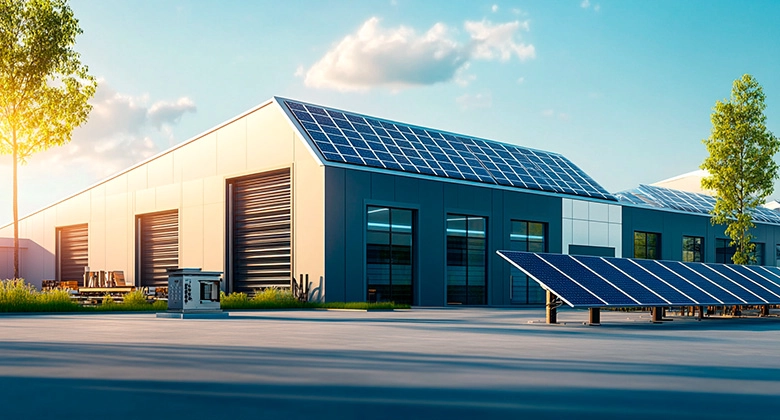

The shifting dynamics of energy-efficient construction
Across Europe and particularly in Ukraine, energy efficiency has moved from a regulatory checkbox to a strategic business asset. Rising energy costs, tightening ESG frameworks, and growing investor scrutiny are pushing commercial developers and property owners to rethink how buildings consume and generate power. At the heart of this shift stands the growing influence of solar power station integration in construction projects - not just as a power source, but as a means of redefining energy performance.
Energy efficiency in buildings is no longer about insulation or heating systems alone. It's about the building’s full energy balance - how much energy it consumes versus how much it can offset or generate. In this context, on-site renewable generation such as solar is becoming a key metric in improving a building’s Energy Performance Certificate (EPC) or national equivalent.
The Ukrainian commercial sector is now actively exploring these solutions, and in some segments - logistics, warehousing, retail - the transition is already measurable. In 2024, the International Energy Agency (IEA) reported that distributed renewable systems can reduce operational building emissions by up to 40% if integrated at the construction phase. That’s a decisive figure, especially in energy-importing economies like Ukraine.
How solar integration boosts energy performance ratings
Ukraine’s path to decarbonization has put pressure on businesses to meet both voluntary and EU-aligned efficiency targets. For new developments, this means embedding energy-saving measures from the blueprint stage. Solar installations, when integrated early, enhance the building’s Primary Energy Demand (PED) scores and boost asset value.
Among the most measurable benefits of solar station implementation:
- Reduced dependency on grid-sourced electricity and fossil fuels
- Improved EPC rating and certification eligibility (such as BREEAM or LEED)
- Long-term predictability of energy costs
- Reduced carbon footprint, aiding corporate ESG metrics
- Improved internal rates of return (IRR) for commercial properties
For example, the integration of a 100 kW solar power station on a mid-sized logistics hub near Lviv increased the facility’s energy class from C to B+, with a calculated annual saving of nearly €18,000 in electricity costs. When indexed against CAPEX, the payback period was just under five years.
From cost to value - shifting the investment perception
The historical perception of solar systems as capital-intensive upgrades is now outdated. With rising grid tariffs and improved panel efficiencies, the business case for solar has changed dramatically. Moreover, the long-term value of solar-enhanced buildings is gaining recognition across real estate and investment sectors.
Modern building evaluation increasingly includes:
- Lifetime energy consumption and cost forecasts
- Net-zero compatibility for future legislative compliance
- Tenant and buyer demand for sustainable infrastructure
- Liquidity premiums for green-certified assets
As a result, developers are opting for larger installations not merely to cover current consumption, but to future-proof buildings. The price of a 1 MW turnkey solar power station, once considered a barrier for most Ukrainian developers, now compares favorably with the compound savings on energy and carbon levies over 15-20 years. Even in conservative estimates, the levelized cost of energy (LCOE) from a modern SPP is below industrial grid rates by 2025.
Building compliance and competitive advantage
Legislation is also catching up. In Ukraine’s alignment with the EU Energy Efficiency Directive, both new construction and major renovations will soon be obligated to meet higher performance benchmarks. Those with integrated renewable generation will naturally be in a better compliance position, avoiding retrofitting costs and delays.
Forward-looking building strategies already include:
- Energy modeling during early design stages
- Roof engineering with PV orientation in mind
- Battery-ready electrical planning
- Grid connection pre-clearance
- Investment partnerships for CAPEX-light deployment (EPC+O&M contracts)
In short, a solar-integrated building is no longer just a green initiative - it’s a regulatory, financial, and market necessity.
Solar energy as a strategic design element
The growing trend is not just about adding panels to roofs. It’s about designing buildings around solar logic - ensuring load distribution, orientation, and architectural components are solar-ready. Ukraine is beginning to see early examples of this - from solar parking shades to south-facing warehouse facades engineered for optimal PV yield.
For industrial developers, energy efficiency is now a competitive metric. Projects with solar integration secure faster permitting, ESG-driven financing, and lower operating risk. In international comparisons, solar-enhanced buildings in Eastern Europe report higher occupancy and investor interest, particularly in logistics and light manufacturing.
A recent example is a cold storage warehouse near Kyiv that commissioned a 500 kW solar power station as part of its expansion. With electricity being one of the highest operating costs in temperature-controlled logistics, the solar system now covers 52% of annual demand and reduced the facility’s carbon footprint by 430 tonnes CO₂ per year.
Conclusion - energy-positive buildings are the future
For developers, architects, and asset managers, the integration of solar power is no longer a niche strategy. It is central to achieving efficiency targets, ESG alignment, and financial resilience. In Ukraine’s energy-sensitive market, where imported power remains volatile, the ability to stabilize costs and reduce emissions simultaneously offers an unmatched advantage.
Solar power stations are no longer optional add-ons. They are foundational to the next generation of energy-smart commercial architecture.

